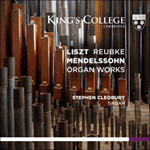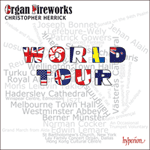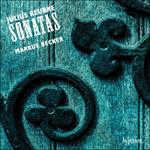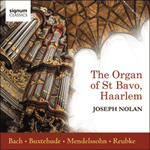
Welcome to Hyperion Records, a British classical label devoted to presenting high-quality recordings of music of all styles and from all periods from the twelfth century to the twenty-first.
Hyperion offers both CDs, and downloads in a number of formats. The site is also available in several languages.
Please use the dropdown buttons to set your preferred options, or use the checkbox to accept the defaults.
Clearly modelled on Liszt’s Fantasia and Fugue on ‘Ad nos, ad salutarem undam’, Reubke’s score is prefaced by some verses from Psalm 94 (printed below). These are not meant to be taken as a literal programme, but rather to provide the emotional colouring of each of the three major sections. Beginning in no discernible key, a theme is given out in the pedals which is full of possibilities for dramatic development and immediately repeated a semitone lower. Rhythmic aspects of this theme are then explored as the music gropes towards, but never conclusively establishes, C minor as the home key. The Larghetto introduces a new theme and signals a gradual increase of pace and harmonic tension out of which the Allegro con fuoco erupts with what could be considered a sonata-form first subject derived from the dotted figure of the initial theme. The same idea, played at half speed and surrounded by swirling arpeggios, provides a second subject which is developed in alternation with the first until the music reaches a powerful climax. The gravely expressive Adagio flows seamlessly from what has gone before and adds another, more consoling, theme to the earlier material. In a final transformation the initial theme becomes the subject of the freely constructed Fugue which follows its course through to the terrifying and vengeful climax.
Grave, Larghetto: O Lord God, to whom vengeance belongeth, shew thyself. Lift up thyself, thou judge of the earth: render a reward to the proud.
Allegro con fuoco: Lord, how long shall the wicked triumph? They slay the widow and the stranger, and murder the fatherless. Yet they say: The Lord shall not see, neither shall the God of Jacob regard it.
Adagio: Unless the Lord had been my help, my soul had almost dwelt in silence. In the multitude of my thoughts within me thy comforts delight my soul.
Allegro: But the Lord is my defence; and my God is the rock of my refuge. And he shall bring upon them their own iniquity, and shall cut them off in their own wickedness.
from notes by Stephen Westrop © 1997
La partition de Reubke, nettement modelée sur la Fantaisie et fugue sur «Ad nos, ad salutarem undam» de Liszt, est introduite par quelques versets du psaume 94 (voir infra) – qui n’entendent pas constituer un programme littéral, mais plutôt fournir la coloration émotionnelle de chacune des trois grandes sections. Un thème, débutant dans une tonalité indiscernable et regorgeant de possibilités de développement dramatique, est énoncé aux pédales et immédiatement répété un demi-ton plus bas. Des aspects rythmiques de ce thème sont ensuite explorés à mesure que la musique tâtonne vers l’ut mineur comme tonalité d’ensemble, mais sans jamais l’établir définitivement. Le larghetto, qui introduit un nouveau thème, signale un accroissement progressif de l’allure et de la tension harmonique, d’où l’allegro con fuoco surgit avec ce qui pourrait être considéré comme un premier sujet de forme sonate, dérivé de la figure pointée du thème initial. La même idée, jouée moitié moins vite et entourée d’arpèges tourbillonnants, fournit un deuxième sujet, développé en alternance avec le premier jusqu’à ce que la musique atteigne à un puissant apogée. L’adagio, à l’expressivité grave, s’écoule, homogène, de ce qui l’a précédé et ajoute un autre thème, plus réconfortant, au matériau antérieur. Dans une tranformation finale, le thème initial devient le sujet de la fugue, de construction libre, qui suit son cours directement jusqu’à l’apogée terrifiant et vindicatif.
Grave, larghetto: Seigneur Dieu de vengeance, parais. Lève-toi, juge de la terre; rends aux orgueilleux ce qu’ils méritent.
Allegro con fuoco: Seigneur, combien de temps les impies fanfaronneront-ils? Ils étranglent la veuve et l’étranger, assassinent les orphelins et disent: le Seigneur ne le voit pas et le Dieu de Jacob n’y prête pas attention.
Adagio: Si le Seigneur ne me secourrait pas, mon âme serait dans le silence absolu. J’avais force affliction en mon cœur, mais tes consolations réjouissent mon âme.
Allegro: Mais le Seigneur est mon refuge et mon espoir. Il leur rendra leur propre iniquité et il les anéantira par leur propre méchanceté.
extrait des notes rédigées par Stephen Westrop © 1997
Français: Hypérion
Die deutlich nach Liszts Fantasia und Fuge über ‘Ad nos, ad salutarem undam’ modellierte Reubke-Partitur wird von Versen des Psalms 94 eingeleitet, die nicht als Programm zu verstehen sind, sondern eher als individuelle Stimmungsvorgaben der drei Hauptteile. Die Musik legt sich zu Beginn auf keine bestimmte Tonart fest, und in den Pedaltönen erklingt ein Thema mit enormem Potential für dramatische Entwicklungen, das gleich im Anschluß einen Halbton tiefer wiederholt wird. Im Zuge der musikalischen Bestrebungen, c-Moll als Grundtonart zu etablieren (was jedoch nie Endgültigkeit erlangt), werden die rhythmischen Aspekte dieses Themas erforscht. Das Larghetto führt ein neues Thema ein und signalisiert eine allmähliche Steigerung des Tempos und der harmonischen Spannung, aus der das Allegro con fuoco plötzlich mit einem, man könnte fast sagen, sonatenformähnlichen ersten Thema hervorbricht, das von der punktierten Figur des Anfangsthemas abgeleitet ist. Aus der gleichen Idee, nur halb so schnell gespielt und von wirbelnden Arpeggios umgeben, entwickelt sich das zweite Thema, das im Wechsel mit dem ersten Thema fortgesponnen wird, bis die Musik schließlich einen gewaltigen Höhepunkt erreicht. Nahtlos schließt sich das ernste, fließende Adagio an, welches das vorhergegangene Material um ein weiteres, doch tröstlicheres Thema bereichert. Durch eine letzte Transformation wird das Anfangsthema zum Thema der frei-konstruierten Fuge umgewandelt, die in einem furchterregenden und nach Vergeltung schreienden Höhepunkt endet.
Grave. Larghetto: Herr Gott, des Rache ist, erscheine. Erhebe Dich, du Richter der Welt; vergilt den Hoffärtigen, was sie verdienen.
Allegro con fuoco: Herr, wie lange sollen die Gottlosen prahlen? Witwen und Fremdlinge erwürgen sie und töten die Waisen und sagen: der Herr sieht es nicht und der Gott Jacobs achtet es nicht.
Adagio: Wo der Herr mir nicht hülfe, so läge meine Seele schier in der Stille. Ich hatte viel bekümmernis in meinem Herzen, aber deine Tröstungen ergötzen meine Seele.
Allegro: Aber der Herr ist mein Hort und meine Zuversicht. Er wird ihnen Unrecht vergelten und sie um ihre Bosheit vertilgen.
aus dem Begleittext von Stephen Westrop © 1997
Deutsch: Manuela Hübner
 Liszt, Reubke & Mendelssohn: Organ Works Liszt, Reubke & Mendelssohn: Organ WorksPerforming three popular virtuosic works for the organ, Stephen Cleobury demonstrates the power of the great Harrison & Harrison organ set within the chapel of King’s College, Cambridge.» More |
 Organ Fireworks World Tour Organ Fireworks World TourA selection of favourites from our much-loved Organ Fireworks series, released to honour Christopher Herrick’s seventy-fifth birthday.» More |
 Reubke: Sonatas Reubke: SonatasThe Liszt-inspired Piano Sonata here finds a worthy new champion, and is coupled with a piano version of the famous Sonata on the 94th Psalm.» More |
 The organ of St Bavo, Haarlem The organ of St Bavo, HaarlemHoused in one of the most spectacular organ cases in the world, the colourful 1738 Christian Müller organ of St Bavo in the Dutch city of Haarlem is the perfect instrument for this all-German programme featuring works by Bach, Buxtehude and Mendel ...» More |

